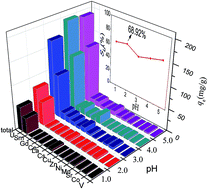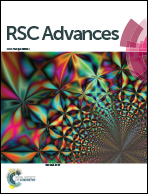Amidoxime-functionalized hydrothermal carbon materials for uranium removal from aqueous solution†
Abstract
A novel solid-phase extractant, i.e., amidoxime-functionalized hydrothermal carbon (AO-HTC), has been synthesized, with acrylonitrile grafted starch serving as the precursor, via a simple, economic and green hydrothermal reaction to separate uranium from nuclear industrial effluents selectively. The characterization and analysis indicated that abundant amidoxime groups (approximately 6.56 mmol g−1) were introduced onto the surface of hydrothermal carbon. The AO-HTC was applied to adsorb U(VI) from aqueous solutions and exhibited a high sorption capacity towards U(VI) due to the strong chelation between amidoxime groups and U(VI). The main results are as follows: (1) AO-HTC could reach its limiting saturation capacity of 724.6 mg g−1 at pH = 5.0 and T = 298.15 K in pure-U(VI) solution, which was an improvement of approximately 18.2 times relative to the raw hydrothermal carbon; (2) the selectivity was above 60% for a wide pH range from 1.0 to 5.0, which has not been reported to date, and reached a maximum of 68.92% in a weak acidic multi-cation solution (pH = 2.0); (3) the uranium sorption on the AO-HTC was a pH-dependent, endothermic and spontaneous process. Furthermore, possible mechanisms for the selective recognition of uranyl ions onto the AO-HTC surface were explored based on experimental characterization and chemical rationales.


 Please wait while we load your content...
Please wait while we load your content...